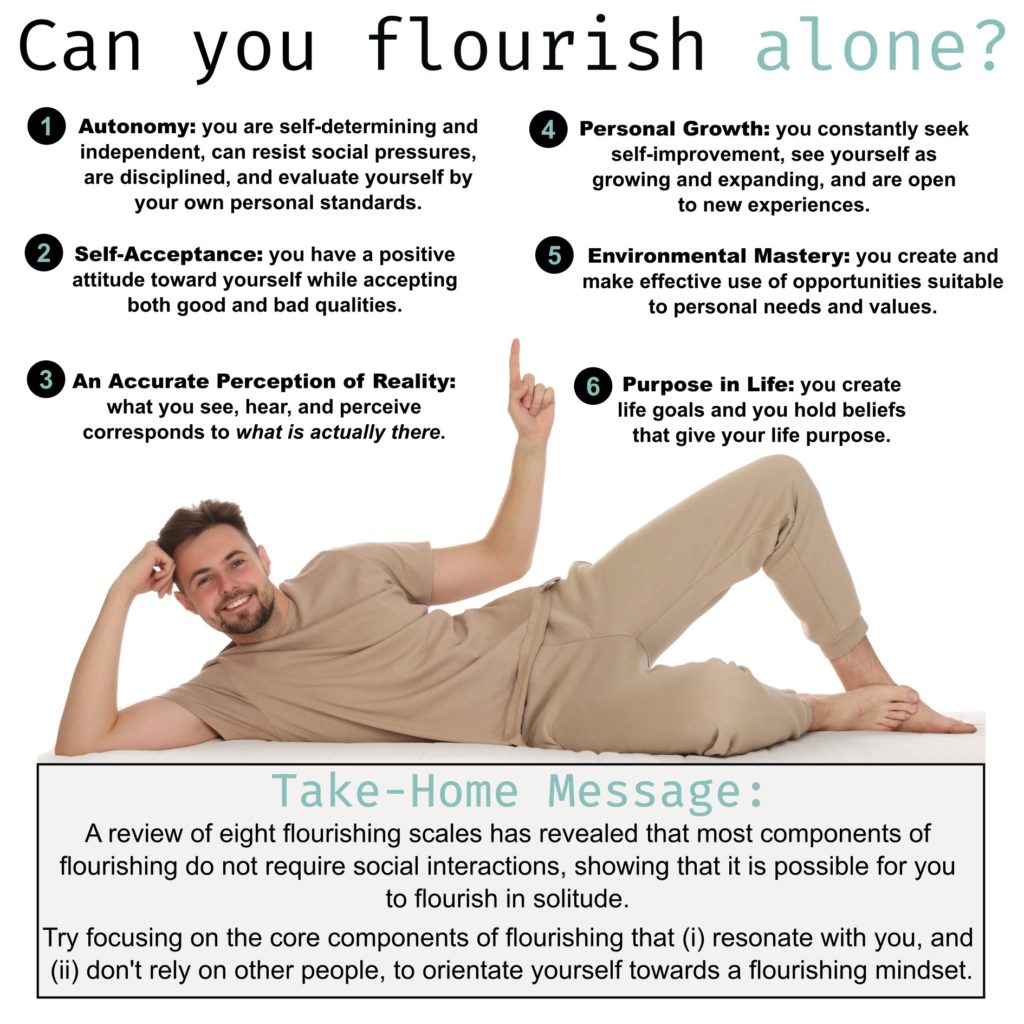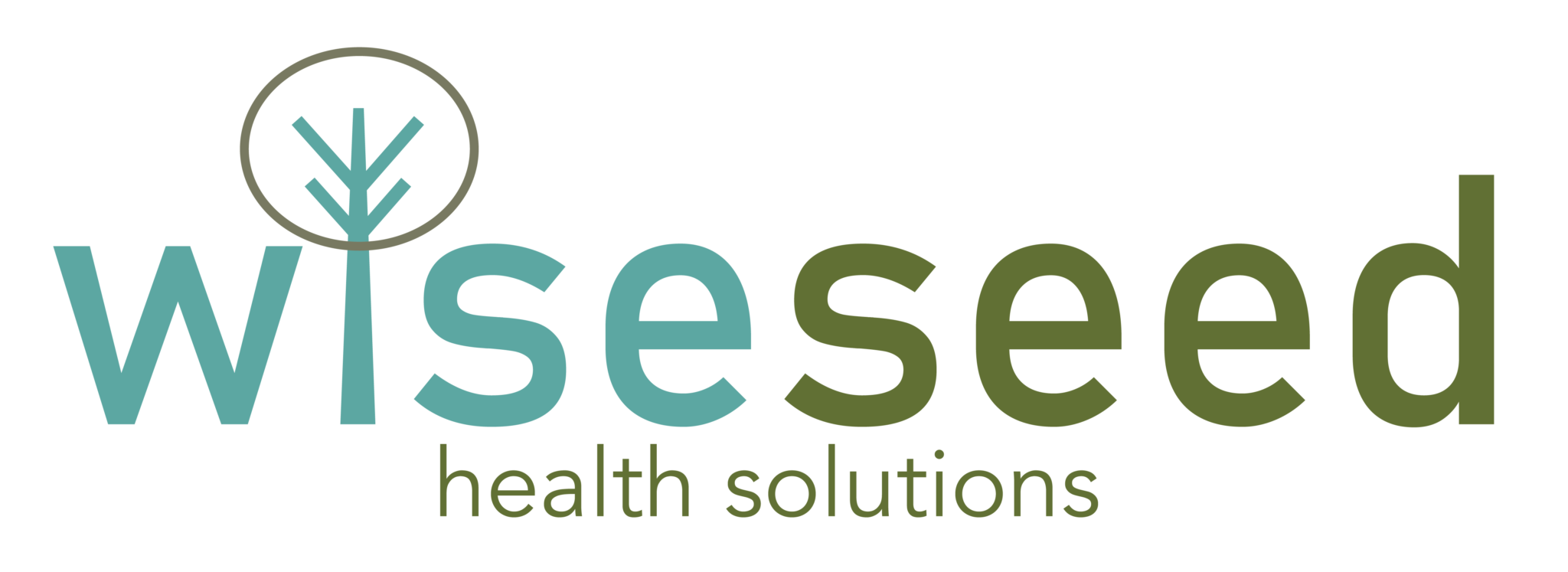Can you flourish alone?

“Flourishing is properly the main human end.”
Ernest Sosa
Executive Summary
Can you flourish alone? I say hell yes!
Why?
Because over 80% of human flourishing doesn’t rely on social connections!
For this reason, I argue that you shouldn’t let being alone get in the way of flourishing.
Instead, try focusing on the core components of flourishing that (i) resonate with you, and (ii) don’t rely on other people, to help orientate yourself towards a flourishing mindset.
Solitude ≠ Loneliness
If you’re alone, so goes the collective wisdom (1), you’re almost certainly depressed, anxious, demented, and certain to die young.
In short, you’re totally screwed.
The problem is that humans are social animals. We evolved to function within tribal groups, and without those oh-so-important social connections, bad sh*t inevitably happens (2).
You see, during the last ice age when our brains evolved, a solitary human was doomed. However, to point out the obvious, we don’t live in a Pleistocene wilderness anymore. Therefore, solitude is no longer the death sentence it once was.
But try telling that to your central nervous system!
Unfortunately, while our culture has evolved at a rapid pace, our laggard genome still thinks we are hunter-gatherers struggling to eke out a miserable existence in the frigid wilderness.
Hence, despite being ensconced in the comforts of modern society, social isolation triggers the primitive loneliness circuits embedded within your Pleistocene brain, providing a powerful emotional drive for you to either seek out and reconnect with your ‘tribe’ (2), or alternatively drink a bottle of wine and eat an entire tub of chocolate ice cream while binge-watching Netflix.
But as I’ve discussed, being alone does not necessarily mean being lonely. Indeed, solitude, or welcomed aloneness, is a state of being ripe with potential for personal growth, artistic expression, and self-reflection (3).
In this article, I continue with this theme by arguing that you can flourish in solitude.
First, what is Human Flourishing?
Flourishing is a broad term that refers to an individual’s pursuit and attainment of a good life that incorporates momentary happiness or pleasure, overall life satisfaction, personal growth, and the realization of one’s potential.
In modern psychology, human flourishing is generally seen as a combination of two aspects of well-being: subjective well-being, and psychological well-being.
Subjective Well-being is focused on the experience of pleasure, satisfaction, and positive affect (positive emotions). The goal is to maximize positive emotional states and minimize negative ones. Subjective well-being is often measured through self-report surveys asking about life satisfaction, frequency of positive emotions, and the absence or low levels of negative emotions. Hedonism, a philosophical paradigm that refers to the pursuit of pleasure and avoidance of pain, is often linked with subjective well-being.
In contrast, Psychological Well-being refers to living a meaningful life, having a sense of purpose, realizing one’s potential, and engaging in fulfilling relationships. The philosophical concept of Eudaimonia, which recommends living life in accordance with virtue and personal growth, is strongly associated with psychological well-being.
My Unashamed Bias towards Eudaimonia
Putting my cards on the table, I believe that flourishing means achieving high levels in both subjective and psychological well-being. It’s about feeling positive emotions (Hedonia/subjective well-being) and living a meaningful life (Eudaimonia/psychological well-being).
However, while I grant that both aspects are important for human flourishing, I personally place a much higher emphasis on psychological well-being/Eudaimonia.
Why?
Because I believe that living a life of meaning, purpose, and fulfilling your potential is highly likely to produce positive emotions and subjective well-being, whereas (at least in my experience) a hedonistic lifestyle absolutely does not guarantee finding meaning, purpose, or realizing one’s potential.
Don’t get me wrong, I recommend utilizing aspects of Hedonism as part of your self-care/regrouping strategy. After all, sometimes you just need to chill-the-f*ck-out. However, focusing on Eudaimonia is your best bet if you really want to flourish over the long haul.
Can Solitary people Flourish?
Surprisingly, answering the question whether solitary people can flourish can be answered objectively. Why? Because modern psychology has been systematically developing methods to measure human flourishing, at scale.
Now, I’m not claiming that psychological assessments of human flourishing are perfect. However, these approaches have been tested, deployed, and validated in a variety of populations, and crucially they provide a reasonable assessment of what independent experts consider to be foundational components of human flourishing.
So to answer the question whether solitary people can indeed flourish, I examined eight widely respected and influential scales of human flourishing, and I simply counted how many items in each scale require social connection.
As you’ll see below, most of the components underpinning human flourishing do not require social interaction. On this basis, I argue that social interaction is not strictly necessary for human flourishing (although it certainly helps!).
Summarizing the Role of Social Connection in Human Flourishing
For interested readers, I’ve provided detailed summaries of each of the flourishing scales at the end of the article. However, when taking all the studies together, the reliance of human flourishing on social connection is on average about 16% (see Table One). That means that roughly 80% of your ability to flourish does not strictly depend on social connections. Hooray!
| Human Flourishing Scale | Social Connection Score (%) |
| Marie Jahoda’s Positive Mental Health List (4) | 0% |
| Carol Ryff’s Psychological Well-Being Scale (5) | 17% |
| Ryan and Deci’s Self Determination Theory (6) | 33% |
| Keyes’ Mental Health Continuum (7, 8) | 25% |
| Waterman and Colleagues’ Eudaimonic Well Being Scale (9) | 0% |
| Diener and Colleague’s Flourishing Scale (10) | 25% |
| Martin Seligman’s PERMA Well-Being Scale (11) | 20% |
| The Huppert and So Framework for Defining Well-Being (12) | 10% |
| Average Social Connection Score | 16.25% |
The observation that most components of human flourishing don’t require social connection is fantastic news for people who, either by choice or by circumstance, find themselves leading a solitary life.
Putting it all together: Building a Comprehensive List for Human Flourishing
The eight flourishing scales analyzed briefly above were created by some of the most influential and creative minds in the field of human flourishing.
While some categories in the flourishing scales clearly overlap, others are unique to a particular scale. So, I thought: Why not distil the collective wisdom of the Author’s reviewed in this article into a single, comprehensive list?
Behold, the List of Flourishing!
Subjective Well-Being (Hedonia)
1. Self-Acceptance: Foster a positive attitude towards yourself, acknowledging and accepting all aspects of self.
2. Positive Emotion: Focus and amplify positive emotions like happiness, joy, love, and contentment.
3. Emotional Stability: Try and maintain a feeling of calm and peace, constantly work on your ability to manage emotions.
4. Optimism: Try and maintain a generally positive outlook about the future.
5. Vitality/Energy: Do your best to generate a sense of dynamism, energy, and being full of life.
Psychological Well-Being (Eudaimonia):
1. Personal Growth/Self-Discovery: Foster a commitment to continued development, openness to new experiences, and realization of personal potential.
2. Purpose and Meaning: Foster a sense of directedness and life goals, search for beliefs that give life purpose, and define personally meaningful objectives.
3. Autonomy: Maintain independence, self-determination, and the ability to resist social pressures to think and act in certain ways.
4. Competence: Foster a sense of accomplishment, mastery, and being effective in your activities.
5. Engagement: Try and become fully absorbed in your activities, experiencing a state of flow, and an interest in daily activities.
6. Environmental Mastery: Strive to increase your competence in managing the environment, controlling external activities, and making effective use of opportunities.
7. Resilience: Nurture your ability to bounce back from adversity and maintain a balanced psychological outlook.
8. Moral Self-Assessment: View yourself as a good person and living a good life, and act accordingly.
9. Integration/Coherence: Develop a balanced psychological outlook, a unifying philosophy of life, and self-control.
10. Reality-Orientation/Accurate Perception of Reality: Try and understand the world as it truly is, accepting both positive and negative aspects of reality.
Social Connection (Partygoia):
1. Positive Relationships/Social Connection: Seek to develop and maintain warm, satisfying, trusting relationships with others, fostering a sense of belonging and connection.
2. Altruism/Contribution to Others: Actively contribute to the happiness and well-being of others.
3. Social Esteem/Respect from Others: Consistently act in such a way that encourages others to respect and care for you.
On Flourishing in Solitude
The List of Flourishing is the distillation of the collective wisdom from some of the greatest minds in positive psychology, and conveniently categorizes the components of flourishing into the buckets of subjective well-being, psychological well-being, and social connection.
Crucially, sixteen out of the eighteen items listed can be accessed in solitude, providing even the most solitary soul with a veritable buffet of flourishing options.
Note that even if you are solitary, you can still partake in social connection via altruism.
Granted, engaging in acts of altruism is very likely a one-way street for solitary people, but that’s kind of the point. Moreover, as altruism is a virtuous act, it reinforces other components of flourishing, such as personal growth, purpose and meaning, and moral self-assessment. So one shouldn’t overlook altruism, even when seeking solitude.
To conclude, keep in mind that the List of Flourishing is merely a guide to help you create your own, personalized approach to leading a good life. Choose your own adventure, then go forth and flourish!
Take Home Message
Let’s be honest, leading a solitary life undoubtedly increases your risk of loneliness.
But this does not have to be so. A review of eight flourishing scales has revealed that most components of flourishing do not require social interactions, showing that it is possible for you to flourish in solitude.
Finally, by distilling the expertise of renowned researchers into a single ‘List of Flourishing’, I’ve provided a range of flourishing options for you to choose from according to your interests and resources.
So why not pick a handful of flourishing items that work for you, and lean into living the good life?

A Brief Review of Human Flourishing Scales
1. Marie Jahoda’s Positive Mental Health List (4)
Marie Jahoda was one of the early pioneers who began to develop a formal definition of human flourishing, way back in the 1950’s! In Dr Jahoda’s own words “the attempts to give meaning to the idea of mental health are efforts to grapple with the nature of man as he ought to or could be” (4).
By systematically reviewing the psychological literature of her time, Dr Jahoda identified what she believed were the six foundational principles of human flourishing (4). Notably, her pioneering work has shaped the study of human flourishing ever since.
1. Attitudes Toward the Self: Dr Jahoda posited that attitudes towards self consists of four components. First, a capacity for honest self-reflection. Second, the development of a reasonable and objective self-assessment. Third, the capacity to accept yourself, warts, and all. And finally, a coherent sense of self, in that a flourishing person knows exactly who they are and what they stand for.
2: Growth, Development, and Self Actualization: Jahoda’s concept of growth encapsulates the ideas of self-actualization, self-realization, growth, or becoming. The growth-orientated individual “must be committed to these higher goals—concern with others, with work, ideas, and interests—and motivated to realize them, in order to achieve them.”
3. Integration: Dr Jahoda considers integration to consist of (i) a balanced psychological outlook (for example, a healthy balance between ego and humility), (ii) a unifying philosophy of life that provides a sense of purpose and meaning, and (iii) self-control and resilience.
4. Reality-Orientation: Reality-orientation refers to the disposition of the individual towards the world. Reality-orientation simply means accepting that there are both positive and negative aspects of reality to consider. Just because the world is not out to get you does not justify boundless optimism. Some events help you, some events hurt you, and some events have no impact on you whatsoever.
5. Autonomy: Jahoda’s concept of autonomy incorporates the ideas of self-determination, independence, and agency. Autonomy means self-regulation in accordance with your personal philosophy and code of ethics, combined with personal agency in terms of independent actions.
6. An Accurate Perception of Reality: Basically, what you see, hear, and perceive corresponds to “what is actually there” (4). An accurate perception of reality, which is the opposite of delusion or psychosis, is essential for flourishing. And yes, this holds true even in our current post-truth, post-modern hell-scape.
Note that items related to social connection are conspicuous by their absence, giving Marie Jahoda’s pioneering framework the low-low score of 0%!
Social Connection Score = 0%
2. Carol Ryff’s Psychological Well-Being Scale (5)
Inspired by Marie Jahonda, Carol Ryff continued to blaze a trail in the study of human flourishing by integrating philosophy with clinical, developmental, existential, and humanistic psychology to propose six core domains of human flourishing.
1. Autonomy: According to Ryff, a highly autonomous person is self-determining and independent, able to resist social pressures to think and act in certain ways, regulates their behavior from within, and evaluates themselves by their own personal standards.
2. Environmental Mastery: A person high in environmental mastery has a sense of mastery and competence in managing their environment, and controls a complex array of external activities, makes effective use of surrounding opportunities, and can choose or create contexts suitable to personal needs and values.
3. Personal Growth: A person experiencing high personal growth has a feeling of continued development, sees themselves as growing and expanding, is open to new experiences, has sense of realizing their potential, sees improvement in self and behavior over time, and changes in ways that reflect more self-knowledge and effectiveness.
4. Positive Relations with Others: A person with positive relations has warm, satisfying, trusting relationships with others; is concerned about the welfare of others; is capable of strong empathy, affection, and intimacy; and understands the give and take of human relationships.
5. Purpose in Life: A person with purpose has life goals and a sense of directedness, they feel that there is meaning to their present and past life, they hold beliefs that give life purpose, and they have aims and objectives for living.
6. Self-Acceptance: A person who accepts themselves has a positive attitude toward themselves; they acknowledge and accept the multiple aspects of self, including good and bad qualities, and they feel positive about their past life.
Social connection is included under item 4 (Positive Relations with Others), giving Carol Ryff’s scale a social connection score of 17%.
Social Connection Score = 17%
3. Ryan and Deci’s Self Determination Theory (6)
Ryan and Deci Human believe that humans can be proactive and engaged with life (i.e., flourishing), or, alternatively, passive and alienated (i.e., failing to flourish). Their research identified three innate psychological needs; competence, autonomy, and relatedness, which together yield flourishing in the form of enhanced self-motivation and mental health (6).
1. Competence: Competence refers to the experience of mastery and being effective in one’s activity.
2. Autonomy: Autonomy refers to feeling one has choice and is willingly endorsing one’s behavior. The opposite experience is feeling compelled or controlled in one’s behavior.
3. Relatedness: Relatedness refers to the need to feel connected and a sense of belongingness with others.
Social connection, in the form of relatedness, makes up one third of the self-determination theory’s core needs, giving SDT a social connection score of 33%.
Social Connection Score = 33%
4. Keyes Mental Health Continuum (7, 8)
Keyes developed an integrative scale to assess human flourishing that incorporates subjective well-being (i.e., the capacity to experience positive emotion), Ryff’s psychological well-being scale outlined above, with five dimensions of social well-being: social integration, social contribution, social coherence, social actualization, and social acceptance (7, 8).
1. Emotional Wellbeing: Emotional wellbeing is determined by how much time during the past 30 days you experience the positive emotions of (i) cheer, (ii) in good spirits, (iii) extreme happiness, (iv) peace and calm, (v) satisfaction, and (vi) full of life. In addition, you also evaluate your overall life satisfaction from “worst possible life overall” to “the best possible life overall.”
2-7. Ryff psychological Wellbeing Scale: Keye’s included Ryff’s six dimensions of psychological well-being, namely 2) autonomy, 3) environmental mastery, 4) personal growth, 5) positive relationships, 6) purpose in life and 7) self-acceptance.
8. Social Integration: Social integration is the evaluation of the quality of one’s relationship to society and community.
9. Social acceptance: People who experience social acceptance trust others, think that others are capable of kindness, and believe that people can be industrious. Socially accepting people hold favourable views of human nature and feel comfortable with others.
10. Social Contribution: Social contribution is the self-evaluation of your social value. It includes the belief that you are a vital member of society, with something of value to give to the world.
11. Social Actualization: Social actualization is your evaluation of the potential and trajectory of society. This reflects your belief in the positive evolution of society and the sense that society has potential which is being realized through its institutions and citizens.
12. Social Coherence: Social coherence is your perception of the quality, organization, and operation of the social world, and it includes a concern for knowing about the world. You feel that society is understandable, sensible, and predictable.
Assessing the social connection score from Keye’s scale is somewhat open to interpretation. For example, one can imagine cases where a person is socially isolated, yet still make positive contributions to society and believe that their society is generally good and heading in the right direction. On the other hand, it’s just as easy to imagine a person who has completely lost faith in society yet remains well connected to friends and family.
In my interpretation of Keye’s Mental Health Continuum, social connection is measured with positive relationships (item 5), social integration (item 8), and social acceptance (item 9).
Social Connection Score = 25%
5. Waterman and Colleagues’ Eudaimonic Well Being Scale (9)
The Questionnaire for Eudaimonic Well-Being (QEWB) was developed by Waterman and Colleague’s specifically “to measure well-being in a manner consistent with how it is conceptualized in eudaimonist philosophy” (9).
In other words, this is pure Eudaimonia, baby!
1. Self-Discovery: Self-discovery encompasses two principles, (i) Know Yourself, and (ii) Choose Yourself. Flourishing demands that each person must first recognize and live in accordance with their true nature, and then strive towards realizing their true nature (i.e., self-realization).
2. Perceived Development of One’s Best Potentials: One must identify those unique potentials that represent the person you able to become, and then actively strive to act upon your unique potentials so that they can become fully developed.
3. A Sense of Purpose and Meaning in Life: Individuals must find ways for putting their skills and talents to use in the pursuit of personally meaningful objectives.
4. Investment of Significant Effort in Pursuit of Excellence: The level of effort one invests in personally meaningful objectives will be considerably greater than in other activities in which a person engages.
6. Intense Involvement in Activities: When you are engaged in personally meaningful activities that make full use of your skills and talents, the intensity of your involvement in these activities should be considerably higher than when engaging in other, more routine activities. Ideally, you should enter a flow state.
7. Enjoyment of Activities as Personally Expressive: One experiences happiness when performing meaningful activities. Flourishing people report that what they are doing is both personally meaningful and enjoyable.
Strikingly, social connection is absent from the Eudaimonic Well Being scale, giving the scale a mighty doughnut with respect to social connection!
Social Connection Score = 0%
6. Diener and Colleague’s Flourishing Scale (10)
The flourishing scale “is a brief 8-item summary measure of the respondent’s self-perceived success in important areas such as relationships, self-esteem, purpose, and optimism” (10). And here it is!
1. Purpose and Meaning: I lead a purposeful and meaningful life
2. Social Connection: My social relationships are supportive and rewarding
3. Engagement with life: I am engaged and interested in my daily activities
4. Prosocial behavior: I actively contribute to the happiness and well-being of others
5. Competence: I am competent and capable in the activities that are important to me
6. Moral self-assessment: I am a good person and live a good life
7. Optimism: I am optimistic about my future
8. Social Esteem: People respect me
In my estimation, item 2 (Social Connection) and item 8 (Social Esteem) measure different, yet complimentary, aspects of social connection, yielding a social connection score of 25%.
Social Connection Score = 25%
7. Martin Seligman’s PERMA Well-Being Scale (11)
Martin Seligman places flourishing at the heart-and-soul of human well-being (11). To better characterize human flourishing, Seligman proposed his PERMA model of human well-being (11).
1. Positive Emotion (P): This refers to cultivating a positive outlook on life and experiencing emotions like happiness, joy, love, and contentment.
2. Engagement (E): This involves being fully absorbed and engaged in one’s activities, experiencing a state of flow.
3. Relationships (R): Flourishing individuals typically have strong, positive relationships. Humans are inherently social creatures, and healthy relationships contribute to our sense of well-being.
4. Meaning (M): This involves having a sense of purpose or direction in life and feeling that one’s life is valuable and worthwhile.
5. Achievement (A): This refers to having goals, pursuing them, and feeling a sense of accomplishment.
In Martin Seligman’s scale, social connectedness (R for relatedness) is one of five items, giving a social connection score of 20%.
Social Connection Score = 20%
8. The Huppert and So Framework for Defining Well-Being (12)
Felicia Huppert and Timothy So eschewed theory and undertook a refreshingly empirical approach to assessing human flourishing (12).
First, they reasoned that flourishing is the polar opposite of depression and anxiety, which are by far the most common of the mental disorders (12).
Next, Hupert and So examined the internationally agreed diagnostic criteria for each condition, and systematically defined the opposite of each symptom to produce their ten features of positive well-being.
Finally, they used the data from 22 European countries consisting of approximately 40,000 people to validate their features of positive well-being. And here they are!
1. Competence: Most days I feel a sense of accomplishment from what I do.
2. Emotional Stability: (In the past week) I felt calm and peaceful.
3. Engagement: I love learning new things.
4. Meaning: I generally feel that what I do in my life is valuable and worthwhile.
5. Optimism: I am generally optimistic about my future.
6. Positive Emotion: Taking all things together, I am generally positive.
7. Positive Relationships: There are people in my life who really care about me.
8. Resilience: When things go wrong in my life it generally doesn’t take me a long time to get back to normal.
9. Self-esteem: In general, I feel very positive about myself.
10. Vitality: (In the past week) I had a lot of energy.
In total, social connection is strictly required for one item out of ten (item 7: Positive Relationships), giving a total social connection score of 10%.
Social Connection Score = 10%
Acknowledgements
Images created by chingyunsong, Liudmila Chernetska, and gregepperson
References and Further Reading
1. F. Wang et al., A systematic review and meta-analysis of 90 cohort studies of social isolation, loneliness and mortality. Nat Hum Behav, (2023).
2. J. T. Cacioppo et al., Loneliness within a nomological net: An evolutionary perspective. Journal of Research in Personality 40, 1054-1085 (2006).
3. C. R. Long, J. R. Averill, Solitude: An exploration of benefits of being alone. Journal for the Theory of Social Behaviour 33, 21-44 (2003).
4. M. Jahoda, Current concepts of positive mental health. (New York : Basic Books, 1958).
5. C. D. Ryff, Happiness Is Everything, or Is It? Explorations on the Meaning of Psychological Well-Being. Journal of Personality and Social Psychology 57, 1069-1081 (1989).
6. R. M. Ryan, E. L. Deci, Self-Determination Theory and the Facilitation of Intrinsic Motivation, Social Development, and Well-Being. Am Psychol 55, 68-78 (2000).
7. C. L. M. Keyes, Social Well-Being. Social Psychology Quarterly 61, 121-140 (1998).
8. C. L. M. Keyes, The Mental Health Continuum: From Languishing to Flourishing in Life. J Health Soc Behav 43, 207-222 (2002).
9. A. S. Waterman et al., The Questionnaire for Eudaimonic Well-Being: Psychometric properties, demographic comparisons, and evidence of validity. The Journal of Positive Psychology 5, 41-61 (2010).
10. E. Diener et al., New Well-being Measures: Short Scales to Assess Flourishing and Positive and Negative Feelings. Social Indicators Research 97, 143-156 (2010).
11. M. E. Seligman, Flourish: A visionary new understanding of happiness and well-being. (Simon and Schuster, 2011).
12. F. A. Huppert, T. T. C. So, Flourishing Across Europe: Application of a New Conceptual Framework for Defining Well-Being. Soc Indic Res 110, 837-1246 (2013).

Ten Minutes is All You Need
Research has shown that ten minutes of moderate-to-vigorous exercise performed each day is enough to significantly reduce your risk of early death.

Ten Minutes is All You Need
Research has shown that ten minutes of moderate-to-vigorous exercise performed each day is enough to significantly reduce your risk of early death.

